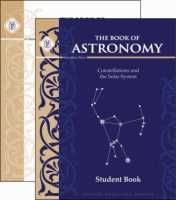 Memoria Press
Memoria Press produces easy to use, classical, Christian materials for home and private schools. Memoria Press products require no previous knowledge of the subjects being taught but are designed with high academic standards.My 10 year old son has always been very interested in the stars, We were excited to have an opportunity to use and review the
Book of Astronomy Set from
Memoria Press.
 The Book of Astronomy Set is geared for grades 3-5 and comes with 2 different books. The student book is 164 pages and consummable. You will need one for each child that is using this curriculum. The Teacher Book is 228 pages. It has the complete student book plus the answer keys to all the exercises plus 4 unit tests and the answer keys.
The Book of Astronomy Set is geared for grades 3-5 and comes with 2 different books. The student book is 164 pages and consummable. You will need one for each child that is using this curriculum. The Teacher Book is 228 pages. It has the complete student book plus the answer keys to all the exercises plus 4 unit tests and the answer keys.
The course has 4 different units with several different topics being covered in each unit. At the end of each unit there are review exercises to go over what was covered. Students will memorize the 15 brightest stars in the northern sky. They will also learn about the different constellations, the zodiac, facts about all of the planets, the solar system, the sun and the moon. They also will be drawing the different constellations and names of the stars in the student book.

Each constellation tells a bit about how the constellation got it's name. For instance Cygnus is a Latinized Greek word meaning "swam" and has been identified with several swans in Greek mythology. Since many of the constellations are named after characters from Greek Mythology, D'Aulaires Book of Greek Myths is a recommended resource for this course. Each constellation has a page number reference to the Book of Greek Myths so you can easily find the information in the book. The lessons also explain the general shape of the constellation and the brightest stars that are a part of it.
You can see a copy of the student book here.
The Book of Astronomy Teacher Guide does not include a suggested schedule. I have had Anthony working on this curriculum 4 days per week. I read the lesson page aloud to him and he completes the written exercises. He has been completing several pages every day.
Anthony has really enjoyed learning about the brightest stars and how the constellations got their name. He loves the drawing exercises. He has learned a lot over the last several weeks.
Having no suggested schedule to follow is both a pro and a con. I wish I had a little more guidance as far as how much per day is recommended. At the same time it is nice to not feel pressured to complete a certain amount in a day especially if you are running low on time.
The Book of Greek Myths is listed as a suggested resource. It is not absolutely necessary, but I do think it would add a lot to this course. We did not have a copy of the book. The book is referenced in almost every lesson and I think having it and reading those pages along with it would have enhanced our learning. There was only one lesson on Hercules that asked questions not covered in The Book of Astronomy and if you don't have the Book of Greek Myths I'm certain the information could be found on the internet or you could simply skip the questions. It is not an absolute necessity especially if you are not interested in the stories behind the constellations.
Members of The Crew reviewed The Book of Astronomy Set, Traditional Logic Set, and D'Aulaires' Greek Myths. To see what my Crew Mates had to say, stop by the Crew Blog.




No comments:
Post a Comment